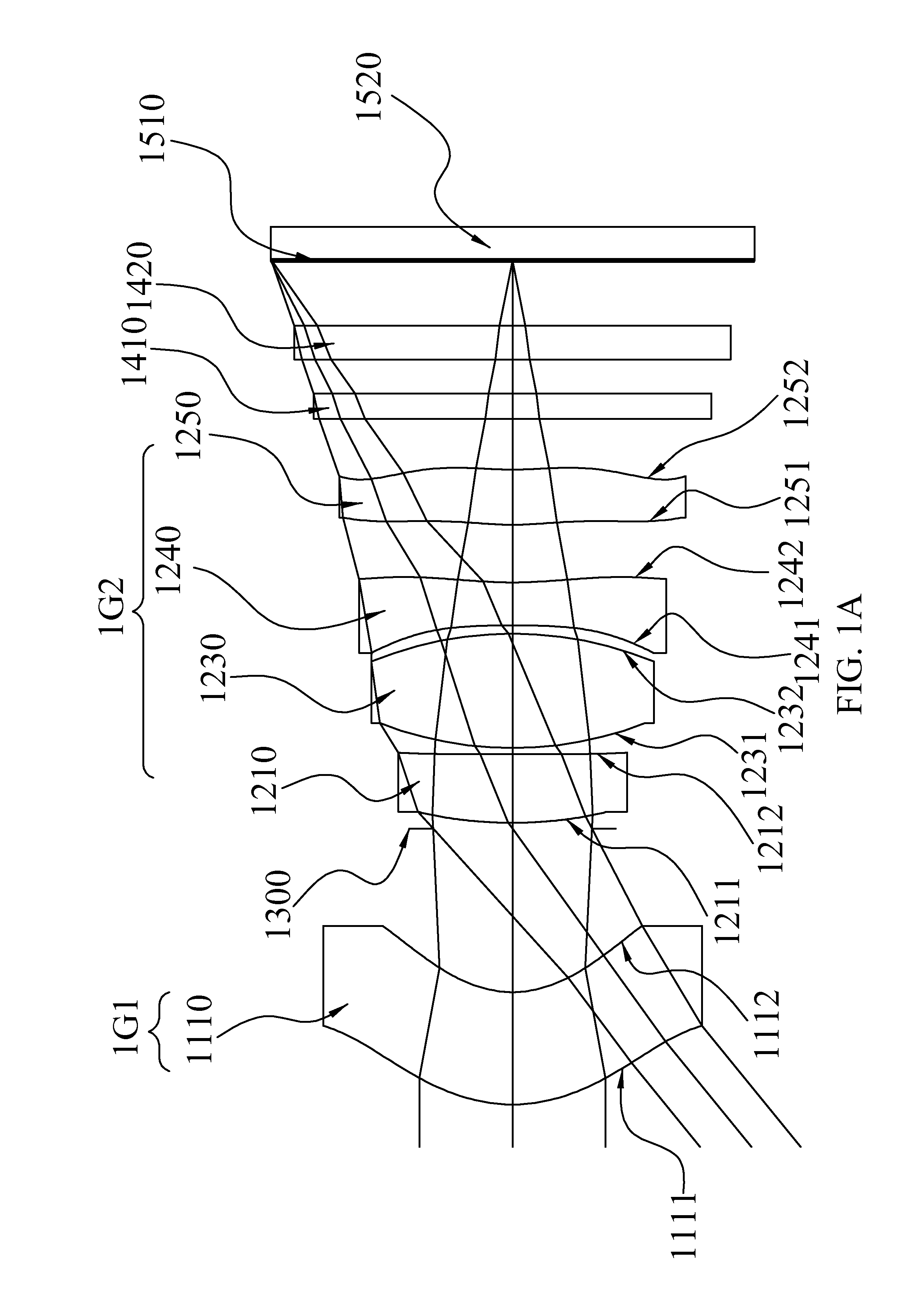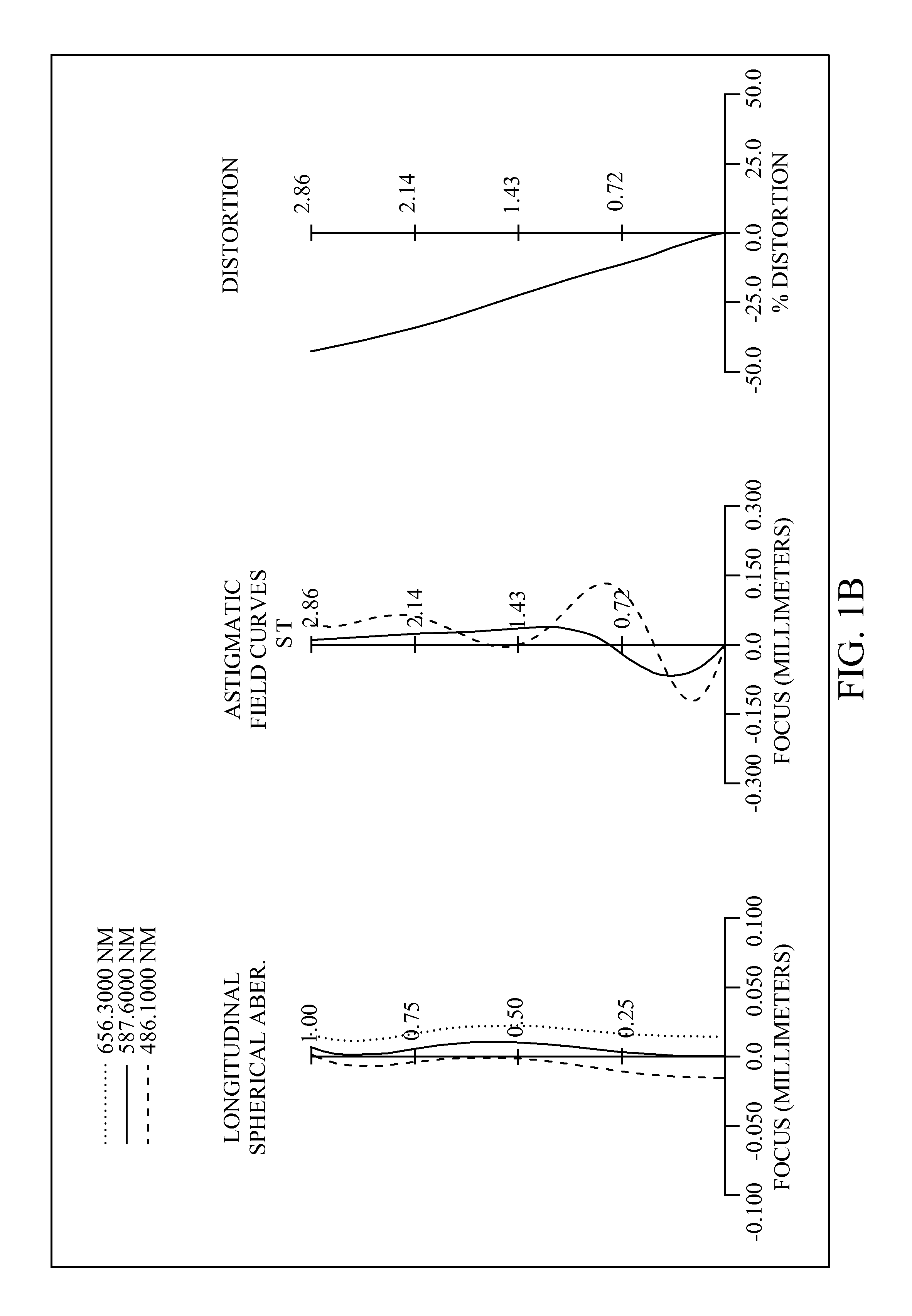Image Taking Optical System
an image taking and optical system technology, applied in optics, instruments, lenses, etc., can solve the problems of difficult aberration correction of light divergence effects, too large refractive angle, and difficulty in meeting the application of compact electronic devices to the total length of the optical system, so as to improve the ability of aberration correction, reduce the total length of the image taking, and improve the effect of aberration correction
- Summary
- Abstract
- Description
- Claims
- Application Information
AI Technical Summary
Benefits of technology
Problems solved by technology
Method used
Image
Examples
first preferred embodiment
[0069]With reference to FIGS. 1A and 1B for a schematic view of an optical system and a series of aberration curves in accordance with the first preferred embodiment of the present invention respectively and Table 1 for the optical data of this preferred embodiment, the image taking optical system comprises a front lens group (1G1), a aperture stop (1300) and a rear lens group (1G2), and the aperture stop (1300) is arranged between the front lens group (1G1) and the rear lens group (1G2). The front lens group (1G1) comprises a front-group first lens element (1110) (labeled as the first lens element in Table 1), and the rear lens group (1G2) comprises four lens elements, being respectively a rear-group first lens element (1210) (labeled as the second lens element in Table 1), a rear-group positive lens element (1230) (labeled as the third lens element in Table 1), a rear-group negative lens element (1240) (labeled as the fourth lens element in Table 1) and a rear-group rear lens elem...
second preferred embodiment
[0075]With reference to FIGS. 2A and 2B for a schematic view of an optical system and a series of aberration curves in accordance with the second preferred embodiment of the present invention respectively and Table 4 for the optical data of this preferred embodiment, the image taking optical system comprises a front lens group (2G1), a aperture stop (2300) and a rear lens group (2G2), and the aperture stop (2300) is arranged between the front lens group (2G1) and the rear lens group (2G2). The front lens group (2G1) comprises a front-group first lens element (2110) (labeled as the first lens element in Table 4), and the rear lens group (2G2) comprises four lens elements, being respectively a rear-group first lens element (2210) (labeled as the second lens element in Table 4), a rear-group positive lens element (2230) (labeled as the third lens element in Table 4), a rear-group negative lens element (2240) (labeled as the fourth lens element in Table 4) and a rear-group rear lens ele...
third preferred embodiment
[0082]With reference to FIGS. 3A and 3B for a schematic view of an optical system and a series of aberration curves in accordance with the third preferred embodiment of the present invention respectively and Table 7 for the optical data of this preferred embodiment, the image taking optical system comprises a front lens group (3G1), a aperture stop (3300) and a rear lens group (3G2), and the aperture stop (3300) is arranged between the front lens group (3G1) and the rear lens group (3G2). The front lens group (3G1) comprises a front-group first lens element (3110) (labeled as the first lens element in Table 7) and a front-group second lens element (3120) (labeled as the second lens element in Table 7). The rear lens group (3G2) comprises three lens elements, being respectively a rear-group positive lens element (3230) (labeled as the third lens element in Table 7), a rear-group negative lens element (3240) (labeled as the fourth lens element in Table 7) and a rear-group rear lens el...
PUM
 Login to View More
Login to View More Abstract
Description
Claims
Application Information
 Login to View More
Login to View More - R&D
- Intellectual Property
- Life Sciences
- Materials
- Tech Scout
- Unparalleled Data Quality
- Higher Quality Content
- 60% Fewer Hallucinations
Browse by: Latest US Patents, China's latest patents, Technical Efficacy Thesaurus, Application Domain, Technology Topic, Popular Technical Reports.
© 2025 PatSnap. All rights reserved.Legal|Privacy policy|Modern Slavery Act Transparency Statement|Sitemap|About US| Contact US: help@patsnap.com



